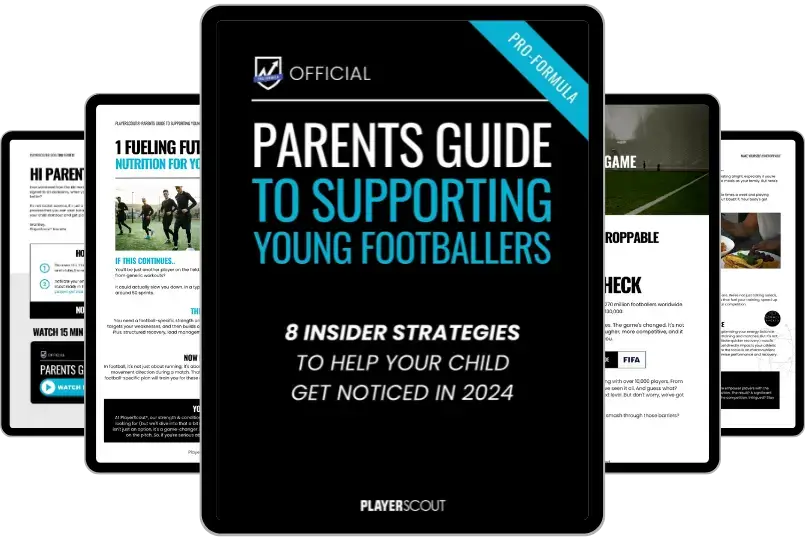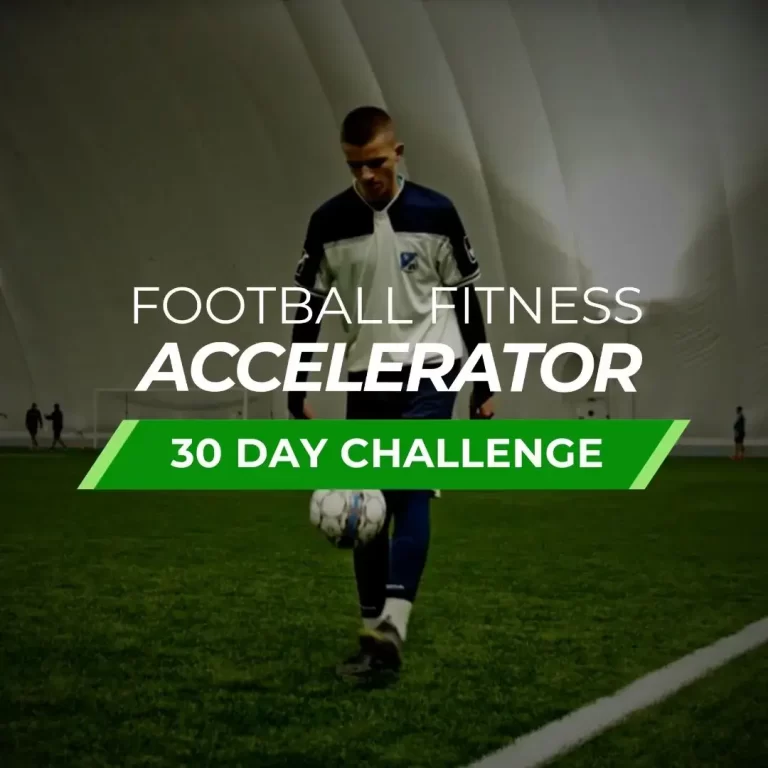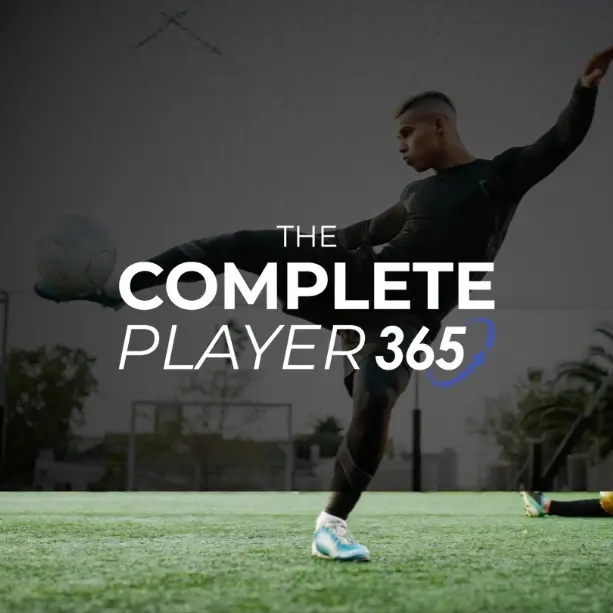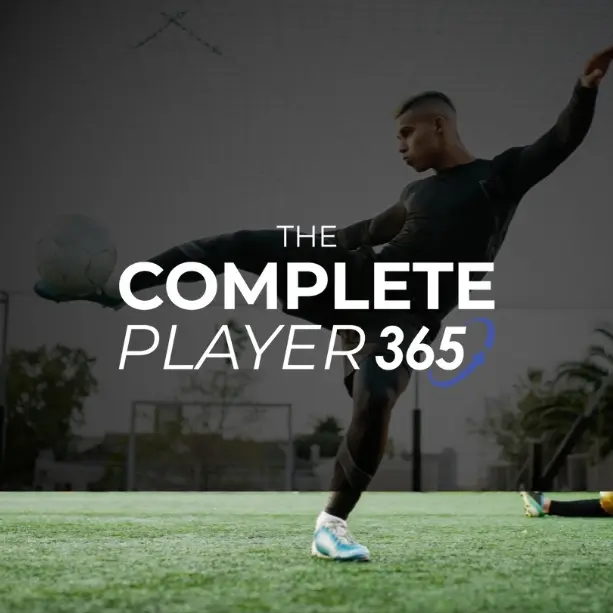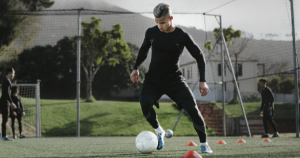Anaerobic fitness for footballers is crucial for peak performance on the pitch. If you’re struggling with late-game fatigue or lack explosive power, you’re not alone.
With over 15 years of experience in player development, PlayerScout has helped over 1.5 million players worldwide enhance their fitness, mindset, and nutrition.
We understand the challenges you face and are here to provide personalized, science-backed strategies to help you gain the edge you need. Explore The Complete Player 365 program.
Ready to take your game to the next level? Let’s dive in.
Contents
Understanding Anaerobic Fitness
Definition and Importance for Footballers
Anaerobic fitness is your body’s ability to perform high-intensity activities without relying on oxygen. For footballers, this is crucial. It means quick sprints, powerful tackles, and rapid changes in direction. These moments can make or break a game.
Improving anaerobic fitness boosts your performance on the pitch. It helps you maintain speed and power throughout the match, reducing fatigue. When you can sustain high energy bursts, you stand out and get noticed.
Comparison with Aerobic Fitness
Aerobic fitness involves lower-intensity activities performed over longer periods. Think of jogging or steady cycling. It relies on oxygen to fuel your muscles. It’s essential for overall stamina and endurance.
Anaerobic fitness, on the other hand, is about short bursts of high intensity. It doesn’t use oxygen the same way. Instead, it uses energy stored in your muscles. For football, both types of fitness are important. Aerobic fitness helps you last the entire match, while anaerobic fitness gives you the edge in those critical, high-energy moments.
Balancing both types of training ensures you’re ready for anything on the pitch. Your body needs to be versatile and prepared for both long runs and explosive sprints. By focusing on anaerobic training, you can enhance your game and catch the eye of scouts and coaches.
FOR PLAYERS
FREE Scouting Secrets 2024
Everything you need to know, to gain exposure, build your profile as a player, and make yourself #UNDROPPABLE.
FOR PARENTS
FREE Guide To Supporting Young Footballers 2024
This FREE guide helps you improve your childs performance on the pitch, enjoyment of the game, and strengthens your bond through football.
Benefits of Anaerobic Fitness for Football
Improved Speed and Explosiveness
Anaerobic fitness helps footballers become faster and more explosive. When you train your body to handle short, intense bursts, you’ll notice quicker sprints and faster reactions. This gives you a significant advantage during matches, helping you outpace opponents and make crucial plays.
Enhanced Performance in Short, Intense Bursts
Football is a game of quick, powerful actions. Anaerobic training focuses on improving your ability to perform at high intensity for short periods. This means better performance during those critical moments in a game – think sudden sprints, quick changes in direction, and powerful kicks.
Reduced Risk of Injuries
Strengthening your anaerobic fitness also helps reduce the risk of injuries. By conditioning your muscles and improving your overall fitness, you’re less likely to suffer from strains and sprains. This keeps you on the field longer and performing at your best.
By focusing on these benefits, you can enhance your game and stay ahead of the competition.
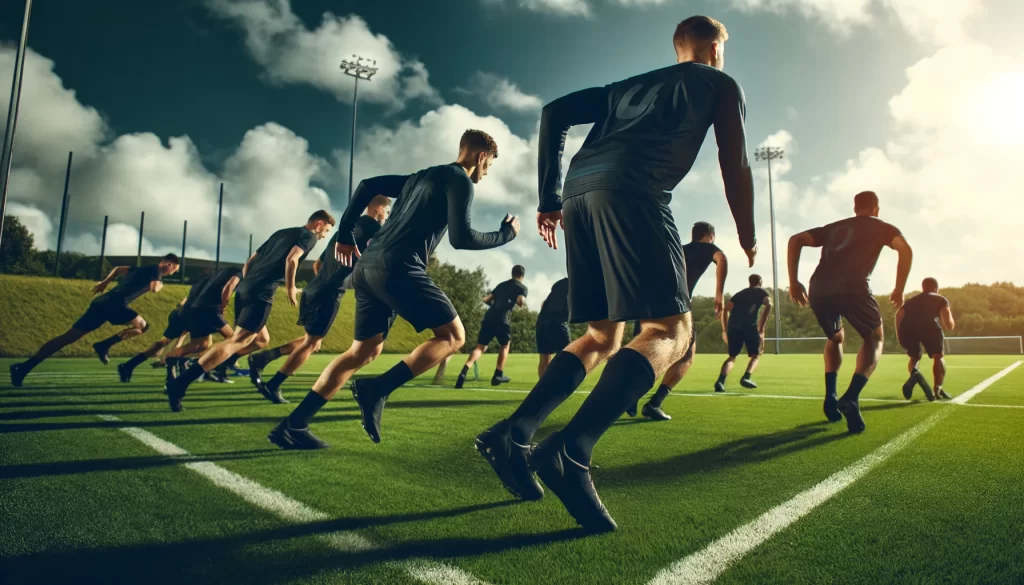
Key Anaerobic Exercises for Footballers
Sprint Drills
Description and Benefits
Sprint drills are essential for improving your anaerobic fitness. They help increase your speed and explosive power, crucial for those quick bursts needed in football. These drills also enhance your overall stamina, allowing you to maintain high-intensity efforts throughout the match.
Step-by-Step Guide with Images/Videos
- Warm-Up: Start with a 10-minute dynamic warm-up to get your muscles ready.
- Basic Sprint Drill: Mark out a 20-meter distance. Sprint as fast as you can from one end to the other. Walk back to the start.
- Interval Sprints: Sprint for 30 seconds, then rest for 30 seconds. Repeat this 10 times.
- Ladder Drills: Use an agility ladder. Sprint through the ladder, focusing on quick feet.
- Cool Down: Finish with a 10-minute cool-down and stretching session.
HIIT Workouts
Overview and Benefits
HIIT (High-Intensity Interval Training) workouts are excellent for boosting your anaerobic capacity. They involve short bursts of intense activity followed by rest periods, perfect for mimicking the stop-start nature of football. HIIT workouts help improve cardiovascular health, burn fat, and build lean muscle.
Sample HIIT Routines Tailored for Footballers
Routine 1: Basic HIIT
- Warm-Up: 5-minute jog.
- Exercise 1: 30-second sprints, 30-second rest (repeat 10 times).
- Exercise 2: 30-second burpees, 30-second rest (repeat 10 times).
- Exercise 3: 30-second high knees, 30-second rest (repeat 10 times).
- Cool Down: 5-minute walk and stretch.
Routine 2: Advanced HIIT
- Warm-Up: 5-minute dynamic stretching.
- Exercise 1: 40-second hill sprints, 20-second rest (repeat 8 times).
- Exercise 2: 40-second jumping lunges, 20-second rest (repeat 8 times).
- Exercise 3: 40-second shuttle runs, 20-second rest (repeat 8 times).
- Cool Down: 5-minute slow jog and stretch.
These routines can be adjusted based on your fitness level and goals.
Interval Training
Overview and Benefits
Interval training is a key component of anaerobic fitness. It involves alternating between high-intensity exercises and lower-intensity recovery periods. This type of training helps increase your VO2 max, the maximum amount of oxygen your body can use during exercise, which is crucial for footballers.
Interval Training Tips
- Consistency: Stick to a regular schedule, aiming for 3-4 sessions per week.
- Intensity: Push yourself during the high-intensity phases, but ensure you recover properly during the rest periods.
- Variety: Mix up your intervals with different exercises to target various muscle groups and prevent boredom.
By incorporating these anaerobic exercises into your routine, you’ll see improvements in your performance on the pitch.
Whether it’s sprinting past defenders or maintaining energy through extra time, these workouts will give you the edge.
READY TO TAKE THE CHALLENGE?
30 Days To Fast-Track Your Fitness, Speed, Strength & Performance

Detailed Workout Plans
Weekly Anaerobic Training Schedules
To build your anaerobic fitness, you need a solid plan. Here’s a simple weekly schedule to get you started:
- Monday: Sprint intervals (30 seconds on, 30 seconds off) – 10 sets
- Tuesday: Rest or light jog
- Wednesday: Hill sprints (15 seconds on, 45 seconds off) – 8 sets
- Thursday: Rest or light jog
- Friday: Shuttle runs (20 meters) – 10 sets
- Saturday: HIIT session (mix of sprinting and strength exercises) – 30 minutes
- Sunday: Rest
Stick to this routine, and you’ll see improvement in your explosive power and endurance.
Combining Anaerobic and Aerobic Exercises
Balancing anaerobic and aerobic exercises is key for overall fitness. Here’s how to combine them effectively:
- Interval Training: Mix short, intense anaerobic bursts with longer, moderate aerobic activities. For example, 1 minute of sprinting followed by 2 minutes of jogging.
- Circuit Training: Include both types in your circuits. Start with a 400-meter run (aerobic), then do 30 seconds of burpees (anaerobic).
- Training Sessions: Dedicate specific days to each. For instance, anaerobic on Mondays, Wednesdays, and Fridays, and aerobic on Tuesdays and Thursdays.
Combining these exercises helps improve stamina and recovery times, giving you the edge on the field.
Tips for Effective Recovery
Recovery is just as important as training. Here are some tips to ensure you recover well:
- Hydration: Drink plenty of water before, during, and after workouts.
- Nutrition: Eat a balanced diet rich in proteins and carbs to repair muscles and restore energy.
- Rest: Ensure you get at least 8 hours of sleep each night.
- Active Recovery: On rest days, engage in light activities like walking or yoga to keep your body moving without overexerting it.
- Stretching: Always stretch after workouts to prevent stiffness and aid in muscle recovery.
Following these recovery tips will keep you in top shape and ready for your next training session.

Success Stories
James’ Journey to Improved Anaerobic Fitness
James joined The Complete Player 365 with a Yo-Yo Intermittent Recovery Test score of Level 14. He wanted to improve his anaerobic fitness for football. By following our structured workouts on his local field and in the gym, he saw significant progress.
James dedicated himself to high-intensity interval training (HIIT) and sprint drills. After six months, his Yo-Yo Test score improved to Level 18. Here’s what James had to say:
“I couldn’t believe the difference in my performance. The workouts were tough, but they paid off. I feel faster, stronger, and more confident on the pitch.“
Common Mistakes and How to Avoid Them
Overtraining and Its Effects
Overtraining is a big issue for footballers trying to improve their anaerobic fitness. It’s easy to think more training equals better results. But, pushing yourself too hard can cause serious problems.
- Fatigue: Your body needs rest to recover. Without it, you’ll feel tired all the time. This impacts your performance on the pitch.
- Injuries: Overtraining increases the risk of injuries. Muscles and joints need time to heal.
- Decreased Performance: Instead of getting better, you might see a drop in your skills and stamina.
How to Avoid Overtraining
- Listen to Your Body: Pay attention to how you feel. If you’re always tired or sore, take a break.
- Rest Days: Include rest days in your training plan. Your muscles need time to repair and grow.
- Balanced Training: Mix high-intensity workouts with lighter sessions. This helps prevent burnout and keeps you improving.
Proper Technique and Form
Using the right technique and form is key to effective anaerobic training. Bad habits can hold you back and even cause injuries.
- Sprinting: Focus on your posture. Keep your body straight, lean slightly forward, and pump your arms.
- HIIT Workouts: Maintain good form throughout. Quality over quantity—better to do fewer reps correctly than more with poor form.
Tips for Proper Technique and Form
- Get Coaching: A coach can help correct your form and give personalized tips.
- Watch Videos: Study videos of professional players and trainers. Notice their technique and try to mimic it.
- Practice: Consistent practice with a focus on form will make it second nature. Always warm up and cool down to prepare your muscles and avoid strain.
By avoiding overtraining and focusing on proper technique, you’ll see better results and stay injury-free. Remember, balance and consistency are key to improving your anaerobic fitness for football.

Advanced Tips for Enhancing Anaerobic Capacity
Nutrition and Supplementation
To boost your anaerobic fitness for football, nutrition is key. Eating the right foods fuels your body and aids recovery.
Key Foods:
- Carbohydrates: Essential for energy. Include pasta, rice, and whole grains.
- Proteins: Help repair muscles. Think chicken, fish, and beans.
- Fats: Necessary for endurance. Use olive oil, nuts, and avocados.
Hydration:
- Drink water regularly.
- Consider electrolyte drinks during intense training.
Supplements:
- Creatine: Enhances short bursts of speed and power.
- Beta-Alanine: Delays muscle fatigue.
Mental Training Techniques
Mental toughness is vital for football. It keeps you focused and resilient.
Visualization:
- Picture yourself succeeding on the field.
- Practice this daily for 5-10 minutes.
Breathing Exercises:
- Use deep breathing to stay calm under pressure.
- Try the 4-7-8 technique: inhale for 4 seconds, hold for 7, exhale for 8.
Goal Setting:
- Set short-term and long-term goals.
- Make them specific, measurable, and realistic.
Positive Self-Talk:
- Replace negative thoughts with positive affirmations.
- Remind yourself of your strengths and past successes.
Incorporate these tips into your routine. They’ll help you become a stronger, faster, and more resilient footballer. Ready to take the next step? Check out our Football Fitness Accelerator for a personalized plan.
OUR SIGNATURE PROGRAM
Become A Fitter, Faster, Stronger, And More Powerful Player Over The Next 12 Months

FAQ
What is anaerobic fitness, and why is it important for footballers?
Anaerobic fitness is the ability to perform high-intensity activities for short bursts without relying on oxygen. For footballers, anaerobic fitness is crucial because it enhances explosive power, speed, and agility on the field. This type of fitness allows players to make quick sprints, rapid direction changes, and powerful tackles, giving them a competitive edge.
How does high-intensity interval training (HIIT) benefit football players?
High-intensity interval training (HIIT) benefits football players by improving their anaerobic capacity, allowing them to perform short bursts of intense activity followed by rest. This mirrors the demands of a football match, enhancing speed, endurance, and overall performance on the pitch. HIIT also boosts cardiovascular health and aids in faster recovery.
What are the best sprint drills to improve anaerobic fitness for football?
The best sprint drills to improve anaerobic fitness for football include short sprints, shuttle runs, and hill sprints. Short sprints, typically 10-30 meters, help build explosive speed. Shuttle runs improve agility and quick direction changes. Hill sprints add resistance, boosting power and endurance, making you more effective on the pitch.
How often should footballers perform HIIT workouts?
Footballers should perform HIIT workouts 2-3 times per week. This frequency helps boost anaerobic fitness without overtraining. Including rest days between sessions allows muscles to recover and adapt. HIIT sessions should be intense but short, lasting about 20-30 minutes. Consistency in these workouts improves stamina, speed, and overall performance on the field.
Can anaerobic fitness improve my overall game performance?
Yes, anaerobic fitness can improve your overall game performance. Anaerobic fitness enhances your ability to perform short, intense bursts of activity, crucial for sprints, quick direction changes, and explosive movements in football. By improving your anaerobic capacity, you’ll experience better endurance, speed, and power on the pitch, giving you a competitive edge.
What is the ideal duration and intensity for HIIT sessions in football training?
The ideal duration and intensity for HIIT sessions in football training depend on the player’s fitness level and goals. Generally, sessions should last 20-30 minutes, with high-intensity intervals lasting 30 seconds to 1 minute, followed by equal or shorter rest periods. Aim for 85-95% of your maximum effort during high-intensity intervals for optimal results.
How can I track my progress in anaerobic fitness?
You can track your progress in anaerobic fitness by monitoring key performance metrics. Start by measuring sprint times, recovery rates, and overall endurance during high-intensity interval training sessions. Regularly test these metrics and keep a training log to compare results over time. This helps you see improvements and adjust your training plan as needed.
What are common mistakes to avoid during sprint drills?
Common mistakes to avoid during sprint drills include improper warm-up, poor running form, and overtraining. Not warming up can lead to injuries, while bad form can reduce efficiency and speed. Overtraining can cause fatigue and hinder progress. Always ensure proper technique, adequate rest, and a thorough warm-up before sprint drills.
How can I prevent injuries while doing HIIT and sprint drills?
To prevent injuries while doing HIIT and sprint drills, it’s essential to warm up properly before starting. Incorporate dynamic stretches and mobility exercises. Always use correct form and technique during workouts. Gradually increase the intensity and volume of your training. Don’t forget to cool down and stretch afterward to aid recovery.
What are some effective recovery techniques after anaerobic training sessions?
Effective recovery techniques after anaerobic training sessions include proper hydration, stretching, and consuming a balanced meal with protein and carbohydrates. It’s important to cool down with light aerobic activity and static stretches. Incorporating foam rolling and getting adequate rest and sleep also help in muscle recovery and overall performance improvement.

Conclusion
Boosting your anaerobic fitness with HIIT and sprint drills is essential for footballers seeking peak performance. Improved speed, power, and reduced fatigue can set you apart on the pitch. Addressing these fitness aspects can significantly enhance your game.
Ready to take your training to the next level? Join our Football Fitness Accelerator 30 Day Challenge to get personalized plans and expert guidance. Start today and become the player you were meant to be.



